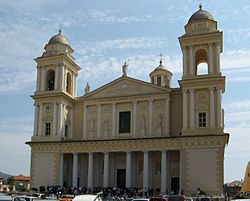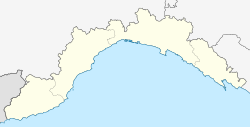Imperia
Imperia Inpêia (Ligurian) | |
|---|---|
| Città di Imperia | |
 Panorama of Imperia | |
| Coordinates: 43°53′N 8°2′E / 43.883°N 8.033°E | |
| Country | Italy |
| Region | Liguria |
| Province | Imperia (IM) |
| Frazioni | Artallo, Borgo d'Oneglia, Cantalupo, Caramagna, Castelvecchio, Clavi, Costa d'Oneglia, Massabovi, Moltedo, Montegrazie, Oliveto, Piani, Poggi, Sant'Agata |
| Government | |
| • Mayor | Claudio Scajola |
| Area | |
• Total | 45.95 km2 (17.74 sq mi) |
| Elevation | 10 m (30 ft) |
| Population (31 August 2017)[2] | |
• Total | 42,328 |
| • Density | 920/km2 (2,400/sq mi) |
| Demonym | Imperiesi |
| Time zone | UTC+1 (CET) |
| • Summer (DST) | UTC+2 (CEST) |
| Postal code | 18100 |
| Dialing code | 0183 |
| Patron saint | Leonard of Port Maurice, Saint John (Oneglia) |
| Saint day | 26 November |
| Website | Official website |
Imperia (pronounced [imˈpɛːrja] ⓘ; Ligurian: Inpêia [iŋˈpeːja] or Inpéria) is a coastal city and comune in the region of Liguria, Italy. It is the capital of the Province of Imperia, and historically it was capital of the Intemelia district of Liguria. Benito Mussolini created the city of Imperia on 21 October 1923 by combining Porto Maurizio and Oneglia, as well as the surrounding village communes of Piani, Caramagna Ligure, Castelvecchio di Santa Maria Maggiore, Borgo Sant'Agata, Costa d'Oneglia, Poggi, Torrazza, Moltedo and Montegrazie.
Imperia is well known for the cultivation of flowers and olives, and is a popular summer destination for visitors. The local Piscina Felice Cascione indoor pool has hosted numerous national and international aquatics events.
History

The name of Oneglia may have its roots in the pre-Roman settlement of Pagus Unelia, on the hill of Castelvecchio, which was probably one of the sex oppida of the Liguri. This spawned Ripa Uneliae, a village down on the coast probably on the site of the modern-day Borgo Peri. Modern Oneglia became established on its modern site around 935AD, possibly after it was destroyed by the Saracens; in 1100 it became a fief of the Diocese of Albenga. In 1298 Oneglia became part of the fiefdom of the Doria family of Genoa; the famous admiral Andrea Doria (1466–1560) was born in the town. The Dorias sold the town to Emmanuel Philibert, Duke of Savoy in 1576, and Oneglia essentially remained a Savoyard enclave in the Republic of Genoa until Italian unification. Nonetheless, it was on the front line in the wars of the House of Savoy; it was seized in 1614 and 1649 by the Spaniards and in 1623 and 1672 by the Genoese.[3] In 1692 it had to repulse an attack by a French squadron; in 1744–45 it was again occupied by the Spaniards, and in 1792 bombarded and burned by the French.[3]
Porto Maurizio was a Roman settlement, Portus Maurici, which, though named in the brief maritime itinerary appended to the Antonine Itinerary,[4] must be an interpolation in manuscripts of that third century document, since it is named after Saint Maurice, leader of the Theban Legion who were not martyred until 286 and could not have been memorialized until the Christianized Empire of the fourth century.[5] It became a Byzantine port after the Gothic Wars of the 6th century, then passed to the Order of Saint Benedict. It was subject to the counts of Turin in the 11th century, and then to the marchesi of Clavesana. Boniface of Clavesana sold the town to the Republic of Genoa in 1288[6] in return for a yearly payment,[3] as part of Genoa's expansion into western Liguria. In 1354 it became the seat of the Genoese vicar of the western Riviera.[3] The town prospered even though control of Genoa passed between the French, the Duchy of Milan, and the Spanish. During the Napoleonic Wars Napoleon Bonaparte himself stopped for a night in Porto Maurizio and spent the night on the Parrasio on the third floor of Palazzo Lavagna. At the Congress of Vienna in 1815, it was awarded to the Kingdom of Sardinia, before finally joining a united Italy in 1861.
Mussolini created the city of Imperia on 21 October 1923 by the union of Porto Maurizio and Oneglia and the surrounding village communes of Piani, Caramagna Ligure, Castelvecchio di Santa Maria Maggiore, Borgo Sant'Agata, Costa d'Oneglia, Poggi, Torrazza, Moltedo and Montegrazie.
Economy
The economy of Imperia is based on tourism, food industry (olive oil and pasta), a specialized agriculture (olive groves and flowers in greenhouses) and on trading and harbour activities. The seaside tourism represents an important aspect of the economy of Imperia.
Geography
Imperia consists of the two historical districts of Porto Maurizio and Oneglia, which lie on either side of the River Impero that gives its name to the city.
Porto Maurizio is situated on a peninsula to the west of the river, stretching along the coastline. It is the wealthiest and most colorful district of the city, threaded by narrow lanes known as carrugi, and its economy centers on the tourist industry. It was a possession of Genoa from the 13th century.
Oneglia (Inéja in Ligurian) lies on an alluvial plain to the east of the Impero, and with its working port is the most modern and industrialized of the two districts. At its centre lies Dante Square, from which radiate some of the main roads of the city.
Climate
Imperia experiences a Mediterranean climate (Köppen climate classification Csa).
| Climate data for Imperia (1981–2010) | |||||||||||||
|---|---|---|---|---|---|---|---|---|---|---|---|---|---|
| Month | Jan | Feb | Mar | Apr | May | Jun | Jul | Aug | Sep | Oct | Nov | Dec | Year |
| Mean daily maximum °C (°F) | 12.8 (55.0) |
12.8 (55.0) |
14.7 (58.5) |
16.6 (61.9) |
20.5 (68.9) |
23.8 (74.8) |
26.7 (80.1) |
27.2 (81.0) |
24.2 (75.6) |
20.6 (69.1) |
16.3 (61.3) |
13.8 (56.8) |
19.2 (66.5) |
| Daily mean °C (°F) | 10.1 (50.2) |
9.9 (49.8) |
11.9 (53.4) |
13.9 (57.0) |
17.7 (63.9) |
20.9 (69.6) |
23.8 (74.8) |
24.3 (75.7) |
21.2 (70.2) |
17.9 (64.2) |
13.6 (56.5) |
11.2 (52.2) |
16.4 (61.5) |
| Mean daily minimum °C (°F) | 7.4 (45.3) |
7.2 (45.0) |
9.1 (48.4) |
11.1 (52.0) |
14.8 (58.6) |
18.0 (64.4) |
20.8 (69.4) |
21.3 (70.3) |
18.3 (64.9) |
15.2 (59.4) |
10.9 (51.6) |
8.6 (47.5) |
13.6 (56.4) |
| Average precipitation mm (inches) | 83 (3.3) |
91 (3.6) |
85 (3.3) |
63 (2.5) |
50 (2.0) |
32 (1.3) |
14 (0.6) |
31 (1.2) |
54 (2.1) |
86 (3.4) |
119 (4.7) |
88 (3.5) |
796 (31.5) |
| Average precipitation days (≥ 1.0 mm) | 6 | 5 | 6 | 5 | 6 | 4 | 2 | 3 | 4 | 6 | 8 | 5 | 60 |
| Source 1: Istituto Superiore per la Protezione e la Ricerca Ambientale (precipitation 1951–1980)[7] | |||||||||||||
| Source 2: Climi e viaggi (precipitation days)[8] | |||||||||||||
Notable sights
Porto Maurizio


- The classical Cathedral of San Maurizio, built between 1781 and 1832 by Gaetano Cantoni, is the largest church in Liguria. (www.parrocchiasanmaurizio.it)
- Old Town, called Parasio.
- Convent of Santa Chiara. First established in 1365, the existing structure dates from 1741.
- There is a small Naval Museum in the town.
Oneglia

- Museo dell' Olivo (The Museum of the Olive)
- Villa Grock, built for the clown Grock (1880–1959)
- Church of San Giovanni Battista, built in 1739–62.
- Calata Giovanni Battista Cuneo, a historic quay lined with restaurants
- The historic Palazzo Municipale in Piazza Danta
Montegrazie
- Church of Santa Maria Maggiore.
- Shrine of Nostra Signora delle Grazie
Transport

Imperia is served by the Autostrada A10 motorway, also known as L'Autostrada dei Fiori which runs along the Ligurian coast between Genoa and Ventimiglia on the French border. The road crosses the city via a series of high viaducts and mountain tunnels over the valley. Two junctions serve the city, one in the west close to Porto Maurizio, and another in the east above Oneglia. The A10 also forms part of European route E80.
Bus services across the Province of Imperia are operated by the public transport body Riviera Trasporti (RT).[9]
The Genoa–Ventimiglia railway line runs through Imperia: the city is served by a central Imperia railway station, on a double-track route opened on 11 December 2016,[10] replacing the old narrow coastal route confined by the sea and long tunnels under the rocky coastline, and therefore built as a single-track railway. The old route was originally built in 1872 and closed with the opening of the new inland route; the city was served by two railway stations serving the two centres of Imperia, Imperia Porto Maurizio and Imperia Oneglia railway station.[11]
Famous residents
Natives of Imperia:
- Gaetano Amadeo (1824–1893), organist and composer
- Edmondo de Amicis (1846–1908), writer and journalist
- Carlo Amoretti (1741–1816), ecclesiastic and writer
- Maria Amoretti (1756–1787), lawyer
- Pellegrino Amoretti,[3] assistant secretary to Charles V, Holy Roman Emperor
- Domingo Belgrano (1730–1795), politician
- Luciano Berio (1925–2003), composer
- Andrea Doria (1466–1560), statesman and admiral
- Renato Dulbecco (1914–2012), Italian–American virologist and Nobel Prize winner
- Luca Fiuzzi (1984), football player
- Saint Leonard of Port Maurice
- Francesco Moraldo, "Creppo di Triora" (1906–2001), Righteous Among the Nations in 1999
- Alessandro Natta (1918–2001), politician
- Giulio Natta (1903–1979), chemist and Nobel Prize winner in 1963
- Giovan Pietro Vieusseux (1779–1863), writer and publisher it:Giovan Pietro Vieusseux
Others:
- Grock (1880–1959), entertainer
International relations
Twin towns – Sister cities
Imperia is twinned with:
 Friedrichshafen, Germany
Friedrichshafen, Germany Rosario, Argentina[12]
Rosario, Argentina[12] Newport, Rhode Island, United States
Newport, Rhode Island, United States
References
- ^ "Superficie di Comuni Province e Regioni italiane al 9 ottobre 2011". Italian National Institute of Statistics. Retrieved 16 March 2019.
- ^ "Popolazione Residente al 1° Gennaio 2018". Italian National Institute of Statistics. Retrieved 16 March 2019.
- ^ a b c d e Chisholm, Hugh, ed. (1911). . Encyclopædia Britannica. Vol. 22 (11th ed.). Cambridge University Press. pp. 123–124.
- ^ Noted in William Smith, A Dictionary of Greek and Roman Geography, vol 2 1873:187, s.v. "Liguria"
- ^ "Portus Maurici, dessen Name auf christliche Zeitalter hindeutet" (Konrad Mannert, Geographie der Griechen und Römen aus Ihren Schriften, Volume 9, Part 1 Book 3, 1823:276); Domenico Anfossi, De sacrarum reliquiarum cultu (1610) suggests a deformation of Maurorum Portus in a passage quoted extensively in Giuseppe Figari, Saggi cronologici della città del Porto-Maurizio 1810:13.
- ^ An earlier notice in the continuator of Caffaro's Annals of Genoa, under the year 1204 and other years, is mentioned in Peter Wesseling's notices of the Antonine Itinerary, Vetera Romanorum itineraria, sive Antonini Augusti itinerarium (Amsterdam 1735:502) s.v. "Portus Maurici".
- ^ "Valori climatici normali di temperatura e precipitazione in Italia" (PDF). Istituto Superiore per la Protezione e la Ricerca Ambientale. Retrieved 26 November 2024.
- ^ "Clima - Imperia (Liguria)". Climi e viaggi. Retrieved 26 November 2024.
- ^ "Profilo e storia della Riviera Trasporti" (in Italian). Retrieved 1 October 2014.
- ^ "Treni, iniziata l'era del raddoppio Andora-San Lorenzo" (in Italian). Archived from the original on 14 December 2016. Retrieved 12 December 2016.
- ^ Whitehouse, Rosie (2013). Liguria : the Bradt travel guide (1st ed.). Chalfont St. Peter: Bradt Travel Guides. pp. 194–196. ISBN 9781841624730.
- ^ "Town Twinning Agreements". Municipalidad de Rosario - Buenos Aires 711. Archived from the original on 19 March 2015. Retrieved 14 October 2014.
External links
- City of Imperia website (in Italian)
- Province of Imperia website (in Italian)
- Imperia Mare Association website (in Italian, English, and French)
- Museo dell' Olivo website (in Italian, English, German, and French)







